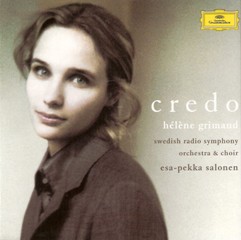111 Years of Deutsche Grammophon - CD 22
111 Years of Deutsche Grammophon - CD 22
Credo - Corigliano / Beethoven / Pärt

John Corigliano (1938 - ) 1 Fantasia on an Ostinato [12:04] Ludwig van Beethoven (1770 - 1827) Piano Sonata No.17 in D minor, Op.31 No.2 -"Tempest" 2 1. Largo – Allegro [8:20] 3 2. Adagio [7:39] 4 3. Allegretto [5:59] Fantasia for Piano, Chorus and Orchestra in C minor, Op.80 5 1. Adagio [3:36] 6 2. Finale: a) Allegro - Meno allegro - Allegro molto - Adagio ma non troppo - Marcia, assai vivace [15:27] Arvo Pärt (1935 - ) 7 Credo for Piano solo, Mixed Choir and Orchestra [15:16] Hélène Grimaud – piano Susanne Carlström – soprano Monika Mannerström – soprano Annika Hudak – mezzosoprano Mats Carlsson – tenor Per Björsund – tenor Wedin Lage - bass Swedish Radio Choir Stefan Parkman – choir master Swedish Radio Symphony Orchestra Esa-Pekka Salonen – conductor
Fantasia On An Ostinato (1985) is based on a famous repetitive passage by Ludwig van Beethoven (Symphony No. 7, second movement). That music is unique in Beethoven’s output because of a relentless ostinato that continues, unvaried except for a long crescendo and added accompanimental voices, for over four minutes. Beethoven’s near-minimalistic use of his material and my own desire to write a piece in which the performer is responsible for decisions concerning the durations of repeated patterns, led to my first experiment in so-called minimalist techniques. ---John Corigliano
The Fantasy in C minor for Piano, Chorus, and Orchestra, Op. 80, was composed in 1808 by Ludwig van Beethoven. Beethoven wrote the piece during the second half of December, an unusually short time by his standards. He commissioned a poet—whose identity is disputed—to write the words shortly before the performance to fit the already written parts. According to Beethoven's pupil Karl Czerny, the poet was Cristoph Kuffner; the later Beethoven scholar Gustav Nottebohm doubted this attribution and suggested the poet may have been Georg Friedrich Treitschke, who in 1814 prepared the final text of Beethoven's opera Fidelio. The work includes a sequence of variations on a theme that is widely felt to be an early version of a far better known variation theme, namely the one to which Beethoven set the words of Friedrich Schiller's Ode to Joy in his Ninth Symphony.
In 1968, the largely unrecognized Estonian composer Arvo Pärt composed Credo, a work for solo piano, chorus, and orchestra, and the twentieth century found its representative voice. The twentieth century was a period of turmoil and chaos, both musically and culturally, and Pärt-himself experiencing a spiritual and musical crisis-captured this sense of transition and change better than any of his contemporaries. Credo is more than just a curious blend of eclecticism, tonality, and twelve-tone serialism, however: it is a violent conflict between those musical theories. Simultaneously, Credo contains the battles between serialism and tonality, the sacred and the secular, and most profoundly, the two great schools of post-World War II musical philosophy: order and chaos. While this piece is one of the key works for an understanding of Pärt's oeuvre as a whole, it demonstrates more importantly the battle of ideas that raged in music and culture throughout the twentieth century.








